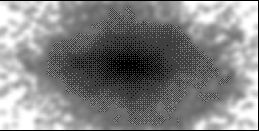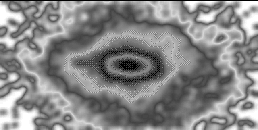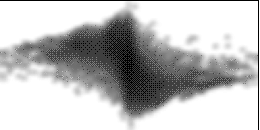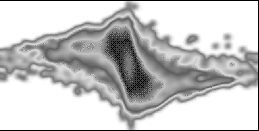
| 
|

| 
|
Figure 2. Remnant produced by an unequal-mass merger. Top: edge-on views. Bottom: line-of-sight velocities versus major axis position. Left: natural grey scale. Right: cyclic grey scale. | |



3.1. Unequal-Mass Mergers
Rapidly-rotating systems may result when a large disk galaxy merges with a smaller companion, as illustrated in a modest survey of unequal-mass encounters (Barnes 1998). In these experiments, both galaxies contained bulges, disks, and halos; the larger galaxy had 3 times the mass of the smaller, and rotated ~ 1.32 times faster. The galaxies were launched on initially parabolic orbits and went through several passages before merging; remnants were evolved for several more dynamical times before being analyzed.

| 
|

| 
|
Figure 2. Remnant produced by an unequal-mass merger. Top: edge-on views. Bottom: line-of-sight velocities versus major axis position. Left: natural grey scale. Right: cyclic grey scale. | |
Figure 2 shows edge-on views and velocity distributions
for an unequal-mass merger remnant. Unlike the products of equal-mass
mergers
(Barnes 1992),
this object is fairly oblate, with axial ratios
b / a  0.9, c / a
0.9, c / a
 0.6. A good deal of ``fine
structure''
is still present due to incomplete phase-mixing, but the edge-on views
show a distinctly disky morphology. The velocity profiles, which
mimic the result of placing a narrow slit along the remnant's major
axis, show that this object is rapidly rotating; in fact, v/
0.6. A good deal of ``fine
structure''
is still present due to incomplete phase-mixing, but the edge-on views
show a distinctly disky morphology. The velocity profiles, which
mimic the result of placing a narrow slit along the remnant's major
axis, show that this object is rapidly rotating; in fact, v/
 2 or more at larger
radii. And as the cyclic version of the
velocity plot makes clear, the line profiles are asymmetric, rising
sharply on the leading side of the peak, but falling off gradually on
the trailing side.
2 or more at larger
radii. And as the cyclic version of the
velocity plot makes clear, the line profiles are asymmetric, rising
sharply on the leading side of the peak, but falling off gradually on
the trailing side.
The initial conditions used for this experiment were fairly generic; the larger disk was inclined by i = 71° with respect to the orbital plane, the smaller disk by i = 109°. Between half and three-quarters of a small sample of unequal-mass merger remnants exhibit the rapid rotation and asymmetric line profiles seen in this example (Bendo & Barnes, in preparation). These objects clearly don't resemble bright ellipticals, but do seem fairly similar to faint ellipticals or S0 galaxies. The morphological and kinematic features which support this classification are due to the incomplete scrambling of galactic disks in unequal-mass mergers. If dissipative collapse is responsible for the rapid rotation of faint ellipticals (Kormendy 1989), a subsequent merger may still be needed to transform the resulting object into something resembling an early-type galaxy.